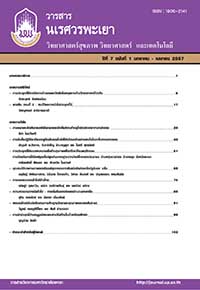การแยกและคัดเลือกแบคทีเรียกรดแลกติกที่ผลิตเบต้ากลูโคซิเดสจากอาหารหมักดอง
Keywords:
แบคทีเรียกรดแลกติก, เบต้ากลูโคซิเดส, Lactic acid bacteria, β-glucosidaseAbstract
งานวิจัยนี้มีวัตถุประสงค์เพื่อคัดเลือกแบคทีเรียกรดแลกติกจากอาหารหมักดองและศึกษาสภาวะที่เหมาะสมต่อการผลิตเอนไซม์เบต้ากลูโคซิเดสจากแบคทีเรียกรดแลกติก การแยกเชื้อแบคทีเรียกรดแลกติกจากอาหารหมักดองจำนวน 54 ตัวอย่าง โดยใช้อาหารเลื้ยงเชื้อ de Man Rogosa and Sharpe agar ที่มี Bromocresol green เป็นอินดิเคเตอร์ เพื่อคัดเลือกโคโลนีที่เปลี่ยนสีของอาหารเลี้ยงเชื้อจากสีเขียวเป็นสีเหลือง พบว่าสามารถแยกเชื้อบริสุทธิ์ของแบคทีเรียได้จำนวน 64 ไอโซเลต การศึกษาการผลิตเอนไซม์ไกลโคซิเดส 4 ชนิดโดยแบคทีเรียกรดแลกติกที่แยกได้ พบว่าเชื้อไอโซเลต RJ16 สร้างเอนไซม์เบต้ากลูโคซิเดสสูงที่สุดคือ 12.66 มิลลิยูนิตต่อมิลลิลิตร และเชื้อไอโซเลต RJ46 สร้างเอนไซม์เบต้าเอ็นอะซิทิล กลูโคซามินิเดสสูงที่สุดคือ 13.11 มิลลิยูนิตต่อมิลลิลิตร การศึกษาสภาวะที่เหมาะสมต่อการผลิตเอนไซม์เบต้ากลูโคซิเดสโดยเชื้อไอโซเลต RJ16 ได้แก่ ระยะเวลาที่เหมาะสม อุณหภูมิที่ใช้ในการเพาะเลี้ยง พีเอชตั้งต้นของอาหารเลี้ยงเชื้อ ชนิดและปริมาณของแหล่งคาร์บอนและแหล่งไนโตรเจน พบว่าเชื้อไอโซเลต RJ16 ผลิตเอนไซม์เบต้ากลูโคซิเดสเพิ่มขึ้นเป็น 2 เท่า (25.20 มิลลิยูนิตต่อมิลลิลิตร) เมื่อเพาะเลี้ยงในอาหารที่มีน้ำตาลกลูโคสความเข้มข้นร้อยละ 4 เป็นแหล่งคาร์บอนและมีเพปโตนความเข้มข้น ร้อยละ 25 เป็นแหล่งไนโตรเจน ค่าพีเอชตั้งต้นของอาหารเลี้ยงเชื้อเท่ากับ 6.0 ที่อุณหภูมิ 45 oซ นาน 36 ชั่วโมง การจัดจำแนกเชื้อแบคทีเรียกรดแลกติกไอโซเลต RJ16 โดยการตรวจสอบลักษณะสัณฐานวิทยาและชีวเคมีพบว่าเชื้อไอโซเลต RJ16 เป็นเชื้อในสกุล Pediococcus sp.
Isolation and selection of β-glucosidase producing lactic-acid bacteria from fermented food
Thida Chaiwangsri1
1 Division of Microbiology and Parasitology, School of Medical Science, University of Phayao, Phayao Province 56000
The objectives of this research were isolation of lactic acid bacteria from fermented food and determination of the condition for β-glucosidase production from isolated lactic-acid bacteria. Lactic acid bacteria were isolated from 54 samples of fermented food using de Man Rogosa and Sharpe agar with bromocresol green as indicator. The colonies which gave a color change of the medium from green to yellow were selected and the pure cultures of 64 isolates were obtained. Glycosidase production from isolate lactic acid bacteria was carried out. It was found that lactic-acid bacteria isolate RJ16 produced the highest amount of β-glucosidase (12.66 mU/ml) and isolate RJ46 produced the highest amount of β-N-acetyl-glucosaminidase (13.11 mU/ml). Optimal conditions for β-glucosidase of isolate RJ16 were determined e.g. time course, temperature, initial pH of the medium, quantity and type of carbon source, quantity and type of nitrogen source. The results found that β-glucosidase production was enhanced twofold (25.20 mU/ml) when lactic-acid bacteria isolate RJ16 was grown in the medium containing 4% as carbon source and 25% as nitrogen source at the initial pH of 6.0, and cultivation at 45oC for 36 hours. The morphological characterization and biochemical tests for lactic-acid bacteria identification indicated that isolate RJ16 was the genus Pediococcus sp.
Downloads
Published
How to Cite
Issue
Section
License
ผู้นิพนธ์ต้องรับผิดชอบข้อความในบทนิพนธ์ของตน มหาวิทยาลัยพะเยาไม่จำเป็นต้องเห็นด้วยกับบทความที่ตีพิมพ์เสมอไป ผู้สนใจสามารถคัดลอก และนำไปใช้ได้ แต่จะต้องขออนุมัติเจ้าของ และได้รับการอนุมัติเป็นลายลักษณ์อักษรก่อน พร้อมกับมีการอ้างอิงและกล่าวคำขอบคุณให้ถูกต้องด้วย
The authors are themselves responsible for their contents. Signed articles may not always reflect the opinion of University of Phayao. The articles can be reproduced and reprinted, provided that permission is given by the authors and acknowledgement must be given.








